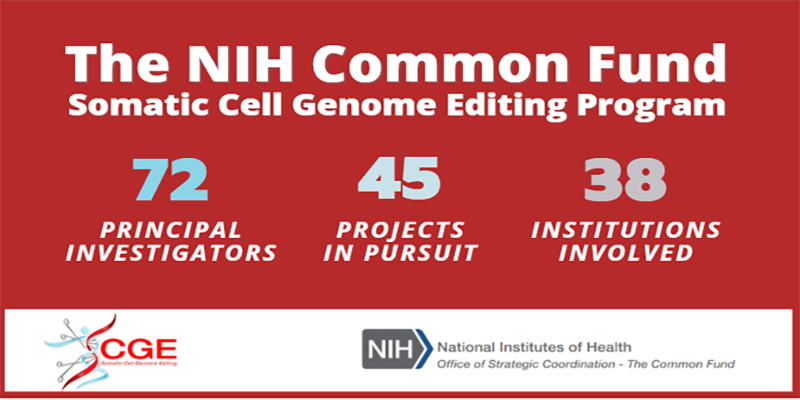
Making changes to a patient’s DNA can have powerful implications for the treatment of disease. Over the past decade, a steady progression of genome editing techniques and technologies has made it possible to precisely change the DNA inside living cells. Researchers continue to make improvements in genome editing techniques and understanding their effects, but significant barriers remain before they will be used widely to treat patients. Specifically, editing cells inside the human body still faces significant hurdles in achieving efficacy and safety. Getting genome editing tools into the various cells of the body will require the development of genome editing approaches specialized to the target cell type and location within the body. The NIH Common Fund launched the Somatic Cell Genome Editing (SCGE) Program in 2018 by assembling a collection of multidisciplinary teams working on individual projects designed to develop solutions to these challenges collectively.
A marker paper written by the SCGE consortium of researchers outlines the goals and strategies of the consortium, which now includes 72 principal investigators from 38 institutions pursuing 45 distinct but well-integrated projects. The goal of the SCGE consortium is to improve the efficacy and specificity of genome editing approaches to reduce the burden of disease. It is accomplishing this goal through components that are working together to develop and improve editing and delivery tools that target specific genes and tissues. They are also collaborating to conduct safety and efficacy tests of these tools via new methods, platforms, and animal models. Information on these tools and other resources will be delivered in an on-line toolkit for therapeutic genome editing that will enable biomedical researchers to more rapidly develop therapies for a variety of genetic disorders.
Reference
- The NIH Somatic Cell Genome Editing Program. Krishanu Saha, Erik J. Sontheimer, P.J. Brooks, Melinda R. Dwinell, Charles A. Gersbach, David R. Liu, Stephen A. Murray, Shengdar Q. Tsai, Ross C. Wilson, Daniel G. Anderson, Aravind Asokan, Jillian F. Banfield, Krystof S. Bankiewicz, Gang Bao, Jeff W. M. Bulte, Nenad Bursac, Jarryd Campbell, Daniel F. Carlson, Elliot L. Chaikof, Zheng-Yi Chen, R. Holland Cheng, Karl J. Clark, David T. Curiel, James E. Dahlman, Benjamin E. Deverman, Mary E. Dickinson, Jennifer A. Doudna, Stephen C. Ekker, Marina E. Emborg, Guoping Feng, Benjamin S. Freedman, David M. Gamm, Guangping Gao, Ionita C. Ghiran, Peter M. Glazer, Shaoqin Gong, Jason D. Heaney, Jon D. Hennebold, John T. Hinson, Anastasia Khvorova, Samira Kiani, William R. Lagor, Kit S. Lam, Kam W. Leong, Jon E. Levine, Jennifer A. Lewis, Cathleen M. Lutz, Danith H. Ly, Samantha Maragh, Paul B. McCray, Jr., Todd C. McDevitt, Oleg Mirochnitchenko, Ryuji Morizane, Niren Murthy, Randall S. Prather, John A. Ronald, Subhojit Roy, Sushmita Roy, Venkata Sabbisetti, W. Mark Saltzman, Philip J. Santangelo, David J. Segal, Mary Shimoyama, Melissa C. Skala, Alice F. Tarantal, John C. Tilton, George A. Truskey, Moriel Vandsburger, Jonathan K. Watts, Kevin D. Wells, Scot A. Wolfe, Qiaobing Xu, Wen Xue, Guohua Yi, Jiangbing Zhou and rest of the SCGE Consortium. Nature, 2021 April 7.


